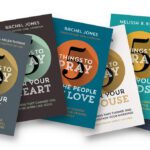I grew up in a family of readers and we were taught to read books from cover to cover, with no sneaky-peaks at the final chapter when you were only half-way through the book. It seemed natural then, that when I became a Christian—where life comes with a book—to start in at the beginning of the Bible, steadily read my way to the end, and then to go back to the beginning to read it all over again—more or less once through each year.
In those early read-throughs, I recognised lots of the familiar Sunday School stories. A good portion of it was unfamiliar but manageable. And some of it (hello Prophets) was barely comprehensible. But I just kept reading.
What an extraordinary discovery it was to find that all of those separate little stories in all of those 66 different books were in fact one big story.
I’d been a Christian ten years when I did my first Bible overview course. What an extraordinary discovery it was to find that all of those separate little stories in all of those 66 different books were in fact one big story. I read the Bible again, and it was beginning to hold together. A few years later I heard a wise person in ministry declare that he regarded the Bible as his chief tool of trade and so felt it important to be across the entire book on an annual basis. I took that comment on and reasoned that the Bible would be my chief tool of trade too—and so committed myself to reading through it in a more intentional way.
Since then, I have used all sorts of Bible reading plans:*
- One list prescribes a portion of the Old Testament, the New Testament and a Psalm every day—a great bread and butter plan.
- A similar one includes a daily portion of Proverbs as well—too bitty for me, but if you love some daily Proverbs it’s the one.
- The Chronological read-through (as best as the experts can get in terms of chronology)—definitely worth doing at least once in your life to read the Psalms, Prophets and epistles in their right place within the action. But Southern Hemisphere readers be warned: by the end of Winter—when you are cold, it’s dark and you just want it to be Spring—you are getting into the hardest parts of the Bible and it’s hard work. Good and very worthwhile work, but hard work.
- More recently I have been using a plan that gets through the whole Bible in a loosely chronological fashion with five sets of readings per week. I love this one. It leaves Sunday free, gives another spare day for catch-ups, and is eminently doable at about four chapters per day. (https://fivedaybiblereading.com/)
Word People
Christians—we are Word people. And being in, through and across God’s Word every year is time so very well spent. Not sure where to start? Here’s an approach.
- If you have never done a Bible overview, go find a course or someone at church who can run you through it. Get yourself familiar with the basic arc of the historical narrative; identify the different genres of writing and start with a foundational sense of how it all hangs together. This will make reading the whole Bible much more satisfying and manageable.
- Choose a plan. A plan keeps you moving through the book and provides some accountability.
- Pray before you read each day, asking God to help you through his Holy Spirit.
- Expect to start with a flourish.
- Expect later on to fall behind. When you fall behind you have four options.
-
- Give up (I don’t recommend that one).
- If you’re not too far behind, try and catch up with some double readings.
- If you’re well behind, start from today’s date with your reading and listen to the chunk you missed with an audio Bible while you’re commuting or cooking.
- Leave the part you missed for this year, start at today’s date and remember you’re going to do this again next year so hopefully you will catch that portion another time.
- Read with a Bible atlas. Every time a place is mentioned see where it is. You will be amazed at how this little exercise will bring your reading alive.
- That said, read at a fair pace. Don’t stop to look up every single thing you don’t understand. Just keep reading. Save the deep dive for another time. You can explore that knotty issue later in the day. Being in a Bible study group will also give you an opportunity for some deep diving. You can probably get through your daily reading from a plan in about 20 minutes if you just keep going. Twenty minutes isn’t too hard to find.
- Perhaps take this adventure on with a friend—who will serve both as an accountability buddy and also someone with whom you can share the delights of your reading.
Finally, expect the first read-through to be hard. There will be some days when you are scratching your head, wondering at what is going on in the text. To that end, I found it very helpful in my early days to use a plan that included a bit of the Old Testament, a bit of the New Testament and a Psalm: it meant that even if I was in a hard patch in one section, there was a good chance there would be something I could grasp more easily in another section.
There is so much to be gained from doing an annual read-through of the Bible.
There is so much to be gained from doing an annual read-through of the Bible, and every year is better than the one before. Over a year or two, you get the basic structure and narrative nailed down. Then you start seeing links between sections of the Bible. You start recognising names and places. Everything beds down. Later you start noticing some of the themes that run through the Bible. The a-ha moments that used to only crop up only in your favourite bits, will start appearing on a daily basis—and in the most unexpected of places. Then you notice God’s grace and mercy, righteousness, justice and love on every page. You start to find that every page points to Jesus. And you will wake up each morning feeling like it’s Christmas, because this is the day that the Lord has made, and it includes reading the next life-giving portion of this marvellous book that God has left for us.
One last suggestion. Don’t wait for the new year. Why don’t you pick a plan and start from today’s date? By the time we arrive at New Year’s Day, you will have already formed a joyful Bible reading habit and you’ll be in no danger of breaking a Bible reading New Year’s resolution.
* You can find a few different plans here.















